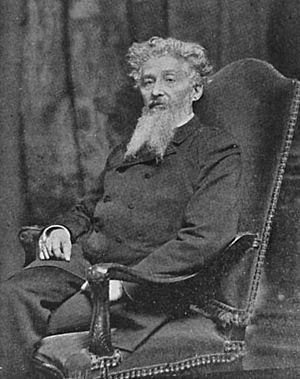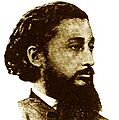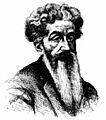Ramón Emeterio Betances facts for kids
Quick facts for kids
Ramón Emeterio Betances y Alacán
|
|
|---|---|
 |
|
| Born | April 8, 1827 Cabo Rojo, Puerto Rico
|
| Died | September 16, 1898 (aged 71) Neuilly-sur-Seine, France
|
| Occupation | Politician, physician, diplomat |
| Partner(s) | Simplicia Jiménez Carlo |
| Parent(s) | Felipe Betanzos Ponce María del Carmen Alacán de Montalvo |
| Signature | |
 |
|
Ramón Emeterio Betances y Alacán (born April 8, 1827 – died September 16, 1898) was a very important person from Puerto Rico. He was a doctor and a strong supporter of Puerto Rican independence. He is known as the main leader of the Grito de Lares revolution. This event helped start the independence movement in Puerto Rico.
Because of this, Betances is often called "El Padre de la Patria" (the Father of the Puerto Rican Nation). He was also known as "El Padre de los Pobres" (The Father of the Poor) because he helped many people in need.
Betances was a skilled doctor and surgeon. He was one of the first to focus on public health in Puerto Rico. He also worked as a diplomat, a poet, and a writer. He represented Cuba and the Dominican Republic in Paris, France. His work was greatly influenced by his beliefs as a Freemason.
Contents
Early Life and Education
Family Background
Ramón Emeterio Betances was born in Cabo Rojo, Puerto Rico. His father, Felipe Betanzos Ponce, was a merchant from Hispaniola (now the Dominican Republic). His mother, María del Carmen Alacán de Montalvo, was from Cabo Rojo and had French roots. They got married in 1812.
Ramón was the fourth of six children. He was the only boy among his surviving siblings. His family was described as being of mixed race. His mother passed away when he was nine. His father later remarried and became a wealthy landowner. He owned a sugar mill and some slaves. It is believed that Ramón later convinced his father to free his slaves.
Studying in France
Young Betances received his early education from private teachers. His father, a Freemason, had a large private library. When Ramón was ten, his father sent him to France to study at the "Collège Royal" in Toulouse. He lived with a Franco-Puerto Rican family who looked after him. Ramón was very interested in science and became a good fencer.
While Ramón was in France, his family tried to change their official race from "mixed race" to "white" in Puerto Rico. This was done to gain more legal rights. Ramón found this process very annoying and hypocritical. He believed his family was "blackish," not "whitish."
In 1846, Betances finished high school. After visiting Puerto Rico, he returned to France to study medicine at the University of Paris. He studied there from 1848 to 1855. During this time, he saw the effects of the French Revolution of 1848. What he saw deeply shaped his political views. He decided that Puerto Rico should seek full Puerto Rican independence from Spain, not just more freedom. In 1856, he became a Doctor in Medicine and Surgeon.
Helping People in Puerto Rico
Fighting the Cholera Epidemic
Betances returned to Puerto Rico in April 1856. A serious cholera epidemic was spreading across the island. It hit the city of Mayagüez very hard. Betances was one of only five doctors for 24,000 people. He and his friend, Dr. José Francisco Basora, warned the city government to take action.
They helped set up a temporary hospital and burned unsanitary slave barracks. Betances worked tirelessly to save lives. Sadly, his stepmother and a brother-in-law died from the disease. He even prioritized treating Puerto Ricans over Spanish military officers who demanded special treatment. For his hard work, the city praised him. However, the Spanish government gave the top medical job to a Spanish newcomer instead of Betances.
Both Betances and Basora were later honored with streets named after them in Mayagüez.
Working to End Slavery
Betances strongly believed that slavery should be abolished. He was inspired by writers and his own experiences. In 1856, he started a secret group called the Secret Abolitionist Societies. These groups worked to free slaves.
One way they did this was by buying the freedom of slave children. At the time, it cost less to free a child who had not yet been baptized. So, Betances, Basora, Segundo Ruiz Belvis, and others would wait at the church on Sundays. They would give money to slave parents before their child was baptized. The parents would then use this money to buy their child's freedom. The child would then be baptized as a free person. This was called receiving the "aguas de libertad" (waters of liberty).
Personal Loss and Return to Medicine
In 1858, the Spanish governor threatened to send Betances away because of his anti-slavery work. Betances left Puerto Rico for France. His niece, María del Carmen Hénri, whom he called Lita, was very important to him. They planned to marry, but Lita became sick and died in 1859.
Betances was heartbroken by Lita's death. He returned to Puerto Rico with her body and buried her in Mayagüez. After this, he focused deeply on his medical work. He also wrote a short story in French, La Vièrge de Boriquén (The Boriquén Virgin), inspired by his love for Lita.
Back in Puerto Rico, Betances opened a very successful surgery and ophthalmology practice in Mayagüez. Even his political enemies called him the best surgeon on the island. He introduced new surgical methods and performed the first surgery using chloroform in Puerto Rico in 1862. He also treated many poor people for free, earning him the name "The Father of the Poor."
Fighting for Independence
Exile and Friendship in the Dominican Republic
The Spanish government tried to banish Betances again. In 1861, he and Segundo Ruiz Belvis fled to the Dominican Republic. There, Betances became close friends with Gen. Gregorio Luperón, a leader fighting for Dominican independence from Spain. This friendship was very important for Betances' later efforts to free Puerto Rico.
In 1862, Betances was able to return to Mayagüez. He and Ruiz Belvis helped establish a municipal hospital for the poor, the Hospital San Antonio, which opened in 1865.
Meeting Simplicia Jiménez
In 1864, Betances met Simplicia Isolina Jiménez Carlo, who became his lifelong partner. She came to his house asking for shelter and stayed with him for 35 years. They did not have children of their own but adopted their godchild, Magdalena Caraguel. Betances built a house for them in Mayagüez, known as the Casa de los Cinco Arcos (House of the Five Arches).
The Seeds of Revolt
Spain was facing many problems in its colonies. To calm things down, they set up a board in Madrid to hear complaints from the colonies. Puerto Rico elected Segundo Ruiz Belvis as its representative. However, the Spanish delegates on the board voted against almost all of Puerto Rico's suggestions, except for the abolition of slavery.
When the Puerto Rican delegates returned, Betances attended a meeting in 1865. After hearing about the failed reforms, Betances famously said: "Nadie puede dar lo que no tiene" (No one can give others what they don't have for themselves). He then suggested starting a revolt to gain independence. Many people agreed with him.
Organizing the Grito de Lares
In 1867, Betances and other revolutionaries were exiled from Puerto Rico by the Spanish governor. Betances and Ruiz Belvis went to New York City and formed the "Revolutionary Committee of Puerto Rico". Betances then returned to the Dominican Republic to plan an armed invasion of Puerto Rico. However, he had to seek safety in the U.S. embassy and then went to Saint Thomas.
While in Saint Thomas, Betances wrote his famous "Los Diez Mandamientos de los hombres libres" (The Ten Commandments of Free Men). This document was based on the French Declaration of the Rights of Man and the Citizen and called for basic freedoms for Puerto Ricans.
Meanwhile, Ruiz Belvis, who was gathering support in South America, sadly died in Valparaíso, Chile. Betances was deeply affected by this news.
Gregorio Luperón met Betances in Saint Thomas and offered to help the Puerto Rican revolution. Betances organized secret revolutionary groups in Puerto Rico, led by people like Manuel Rojas and Mathias Brugman. He also asked Mariana Bracetti to sew a flag for the revolution, similar to the Dominican Republic's flag. Betances planned to send a ship with supplies, but it was seized by authorities.
All these events led to the "Grito de Lares" uprising, which had to start earlier than planned, on September 23, 1868. Betances was still trying to send help when the revolt happened. After the uprising failed, Betances never openly returned to Puerto Rico.
Life in Exile
In New York and Hispaniola
Betances moved to New York City in 1869, continuing his work for Puerto Rican independence. He joined the Cuban Revolutionary Junta, which was fighting for Cuba's freedom. He also worked to prevent the Dominican Republic from being annexed by the United States.
Betances later spent time in Haiti and the Dominican Republic. He strongly believed in an Antillean Confederation, where Cuba, Haiti, the Dominican Republic, and Puerto Rico would unite to protect their freedom. He also warned Cuban revolutionaries against giving too much power to the United States, fearing American interference.
Return to France
In 1872, Betances returned to Paris with Simplicia Jiménez. He continued to fight for Puerto Rico's independence for the next 26 years. He was very happy when slavery was officially abolished in Puerto Rico on March 22, 1873.
Betances became the first secretary of the Dominican Republic's diplomatic mission in France, acting almost like an ambassador. He also supported the Cuban independence movement, raising funds and helping to free Cuban leaders like José Maceo from prison.
He became friends with Máximo Gómez, a Cuban military leader, who offered to lead a revolt in Puerto Rico if needed. Betances also worked with José Martí, the famous Cuban revolutionary, becoming the leader of Cuban revolutionaries in France. After Martí's death, Betances continued to support the Cuban cause under Tomás Estrada Palma, even though he had some disagreements with him.
In 1897, Betances helped plan another uprising in Puerto Rico, known as the Intentona de Yauco, but it also failed.
Final Efforts and Death
In 1887, Betances was awarded the rank of Knight of the Legion of Honour by the French government for his diplomatic and medical work. He had refused it before, but accepted it as a tribute to Puerto Rico.
In 1898, as the Spanish–American War approached, Betances tried to use his diplomatic contacts to prevent the United States from taking over Puerto Rico. He knew Puerto Ricans might welcome an American invasion, but he strongly believed Puerto Rico should be independent. He famously said, "No quiero colonia, ni con España, ni con los Estados Unidos" ("I don't want a colony status, neither with Spain nor with the United States"). When asked why Puerto Ricans weren't rebelling, he responded, "¿Y qué les pasa a los puertorriqueños que no se rebelan?" ("And what's wrong with Puerto Ricans that they haven't yet rebelled?").
Ramón Emeterio Betances died in Neuilly-sur-Seine, France, on September 16, 1898. His body was cremated and buried in the Père Lachaise Cemetery in Paris. He died almost in poverty.
Years later, in 1920, his ashes were brought back to Puerto Rico. A huge crowd of 20,000 people welcomed his remains in San Juan. His remains were then taken to Cabo Rojo and later moved to a monument in the town's plaza, which is named after him. A plaque honoring him was also placed at his Paris house in 1998.
Legacy and Impact
His Writings
Betances' biographers are publishing his complete works in 14 volumes. The first volumes include his medical writings and personal letters. He also wrote a novel, "Les Deux Indiens: Épisode de la conquéte de Borinquen" (The Two Indians: an episode of the conquest of Borinquen), which praised Puerto Rican identity.
Important Places
Several places are named after Betances:
- An elementary school in Hartford, Connecticut.
- A plaza and mural in Boston, Massachusetts.
- The main road in Mayagüez and a major avenue in Ponce.
Political Influence
Betances was the first openly nationalistic leader in Puerto Rico. The Grito de Lares is seen as the "birth of Puerto Rican nationality," with Betances as its "obstetrician." His actions helped create a strong sense of Puerto Rican identity. His ideas, though seen as rebellious at the time, had a big impact on the island's history. He was a pioneer of Puerto Rican liberalism.
He also strongly supported the unity of the Greater Antilles (Cuba, Haiti, Dominican Republic, and Puerto Rico). José Martí considered Betances one of his "teachers" or inspirations. Betances' work greatly helped the Cuban independence cause.
Medical Contributions
Betances wrote two important medical books. His doctoral thesis, "Des Causes de l'ávortement" (The Causes for Miscarriage), was used as a textbook in some European universities. His book "El Cólera: Historia, Medidas Profilácticas, Síntomas y Tratamiento" (Cholera: History, Preventive Measures, Symptoms and Treatments), based on his experience in Mayagüez, was used as a public health textbook in Latin America.
Literary Works
Betances was also one of the first Puerto Rican "writers-in-exile." He wrote a novel, "Les Deux Indiens: Épisode de la conquéte de Borinquen" (The Two Indians: an episode of the conquest of Borinquen), which was published in 1853. He also wrote poetry in French and Spanish for literary magazines in Paris.
Major Works
- Toussaint Louverture, Les Deux Indiéns (1852)
- Un premio de Luis XIV (1853)
- Las cortesanas en París (1853)
- La Vierge de Borinquén (1859)
- El Partido Liberal, su progreso y porvenir (translation from the French original by Édouard René de Laboulaye, 1869)
- Washington Haitiano (essay about Alexandre Pétion, 1871)
- Los viajes de Scaldado (1890)
Betances also wrote one of the two prologues of the book "Les détracteurs de la race noire et de la République d'Haiti" (The detractors of the black race and the Republic of Haiti, 1882).
Images for kids
See also
 In Spanish: Ramón Emeterio Betances para niños
In Spanish: Ramón Emeterio Betances para niños
- List of Puerto Ricans
- List of revolutions and rebellions
- Revolutionary wave











